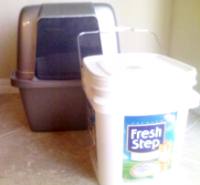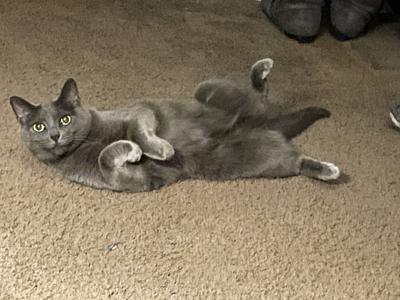Cat Litter Box Basics (Part 1) The All Important Kitty Toilet
The cat litter box is one of the most important items in your cat's life. Along with food, toys, protection, attention, and a place to sleep, providing the right box is one of the key elements of good cat care.
 Extra large cat box with cover and Fresh Step litter
Extra large cat box with cover and Fresh Step litterIn nature, wild cats will often choose to eliminate on loose, sandy soil. They can then easily cover their tracks.
Much to the frustration of many gardeners, roaming house cats carry on this habit by using gardens as toilets, which has created a whole sub-industry around cat repellent products.
The good news is that this fondness for loose soil usually makes litter box training fairly easy. That article is sort of a "cat litter box training 101."
As I describe in that article, you and your cat will be fine if you set up the right environment and let your cat have at it. Still there are some decisions to be made and each kitty (and house) is different.
Some key decisions to make about the cat litter box involve:
- Box type
- Size and number of kitty boxes
- Placement
- Multi-cat households
- Multi-floor houses
- Automatic cat litter box (versus manual cleaning)
- Age considerations (kitten, senior cat)
- Illness or mobility issues
- Type of litter to use
Note: Prolonged problems with inappropriate elimination (as in "my cat won't use the litter box") are often cited as the number one behavioral reason adult cats are brought to shelters.
Considering that many shelters will put animals to death if they can't find homes for them, cat litter box problems are a life and death situation for cats. The cat litter box, therefore, is a crucial aspect to the well-being of all domestic cats.
All of the above aspects can play a role in creating these problems. If you or someone you know is experiencing cat litter box problems, I urge you to read through the information on this site, work with your veterinarian and/or a cat behaviorist, and solve the problem.
Below, we'll cover these issues and more...
Types of Cat Litter Boxes
Generally speaking, there are several types of cat litter boxes we can talk about. The first is your basic open box. This is usually a plastic box with four sides. Larger boxes have cut outs for easy entry and exit.
The next box type uses a cover. Some of the covered models have clear flaps, and others have an open entry/exit. Covers tend to keep "litter swishers" from pushing lots of litter outside the box and onto the floor. They also tend to keep the smells in.
Some cats seem to like the privacy aspect that the cover provides. Others, however, won't like it. Large cats especially, or those that like to have tails or heads out of the box may find it confining.
Sensitive feline noses may take offense to the smells as well. You should always keep a clean box, but cleanliness is especially important where covers are involved.
The next step in covered cat litter boxes is litter box furniture. These products range from an actual box that acts as a planter to a fully enclosed piece of furniture with an opening and/or ramp that the box goes in. The latter will put the box totally out of site. As in the covered versions, this tends to keep the smells in, so you have to be alert to that.
These can be great in some situations if you want a hidden cat box, and the ramp also helps to reduce the amount of litter tracked around the house. Here is a more complete discussion on litter box covers, and manual and automatic covered boxes.
Booda makes a line of stylish covered boxes in various colors.
Another type of box is the self cleaning litter box. Some of these, such as the Litter Robot and LitterMaid are electronic and use a motor mechanism.
The electronic models are often referred to as automatic self cleaning.
You can read more about the various models and accessories of LitterMaid boxes here.
Others, such as the Feline Pine and Omega Paw models, are also referred to as self cleaning, but are not electronic. Both of these boxes have a rather unique approach to reducing the chore of cleaning the box.
We cover those two, as well as some electronic self cleaning models here.
Box Size and Number
A kitten-sized cat litter box is right for kittens. Adult cats should have adult-sized boxes. Once your cat is big enough, it's time to graduate to an adult size.
If you have more than one kitty in the house, it's probably best to get an extra large box (more than one as we'll discuss below). In my experience though, even with one cat, the extra large size seems to allow for the right amount of litter.
If you have a very large cat, say over 18 lbs, or a "swisher" that tends to throw litter around, you can get a larger plastic tub and use that as a litter box. Rubbermaid makes quality containers that won't bend or twist too much under the weight of litter or cat paws, and they tend to have high sides. Larger containers with higher sides also help with overspray from those cats who like to urinate up against the side of the box.
The downside is there is no cut out for entry/exit, so if your cat has a mobility problem this may not work. In order to make it is easier on your cat, whether or not there is a mobility problem, you can set up a ramp, some steps, or get one of the litter box furniture options that has a ramp built-in.
The all-important one plus one rule:
The question that everyone should ask themselves is "how many litter boxes should I have?"
The answer is that you should have one box for every cat in the house, plus one extra. This is known as the one plus one rule and should be followed even if you have only one cat.
There are several reasons for this. First, cats usually like their boxes to be clean. While some cats won't complain too much, many cats won't even use a box that has just been used, even if they were the one to use it last. Some cats like to urinate in one box, and defecate in the other. So, having an extra box helps with this.
In single cat households, two cat litter boxes means each one is usually cleaner more of the time. It also means that in a large house, your cat doesn't have far to go to reach a box. This can be important as your cat ages and becomes less active, or develops mobility problems due to arthritis or some other condition.
In multi-cat households, one box for each cat plus one additional box means again, that each box stays cleaner, and there is always an alternative box to use that may not have been recently visited. More on multi-cat litter box issues below.
Box Placement
Location, location, and... location! Just as in real estate, it's all about location. This piece of kitty real estate needs to be placed in the right spot. Placing the box in the wrong spot can lead to litter box problems.
There are a number of "no no's" when it comes to cat litter box placement:
- Too close to the food or water bowls
- Too close to high traffic areas
- Too close to noisy areas
- Too out of the way or difficult to get to
- Placed on the wrong surface
The above seems obvious, but some people fail to realize that cats don't eliminate where they eat. They also don't like lots of activity or noise where they eliminate. In addition, if you put a cat litter box in a location that your cat doesn't frequent, they may be reluctant to use it.
General speaking, bathrooms, laundry rooms, and kitchens are probably not good areas to place the box. Bathrooms are not only busy, but sometimes the door is closed, restricting access to the box.
Laundry rooms have detergent and bleach smells that cats dislike, in addition to noisy machinery. Yet, time and time again, these are the locations that people often use for the box.
I'm not saying that these places can't be used. It's just that many people use places that end up being too busy or noisy to be viable. Then, when their cat stops using the box, they wonder why. Sometimes it's difficult to know why these problems occur, but other times it's crystal clear.
So, where should the boxes be placed?
Each litter box should be placed in an area of the house that your cat frequents, but one that is not too busy. The area should be quiet, away from the food and water bowls, and preferably should allow for multiple escape routes.
Also, there are some cats who will prefer that the box is placed on a hard surface, such as a tile floor rather than carpeting. Some cats will prefer to actually push the litter aside, and defecate on the hard bottom of the cat box, then cover it up. This is common with longer haired cats (Frankie, who has medium-long hair, sometimes does this). If your cat has issues with inappropriate elimination, try changing the surface the box is placed on.
Multi-Cat Household Issues
There are several issues with respect to multi-cat households:
- number of boxes
- escape routes
- aggression between housemates
In order to prevent cat litter box problems, you need the right number of boxes, as described by the one plus one rule above. If you have 3 cats, you need 4 boxes, plain and simple. This allows each cat to be able to choose a free box at all times, and keeps each box cleaner.
Some cats like to torment their housemates just before, after, or during their toilet visits. Teddie, for example, likes to sneak up on Frankie when Frankie is using the box. Sometimes, she goes right up to her and swats her, other times she stalks her and pounces.
Normally, this doesn't cause any issues, but some cats do have a problem with it and will sometimes stop using the box if they're attacked every time they use it. Frankie can hold her own and will get her revenge later, so it has never caused a problem, but it might. She and her sister have a good relationship, and this is just one of those feline behaviors that develop and they work it out.
In order to ease the pain of these experiences for the "victim" you should place your boxes in locations that have multiple escape routes, and in such a way that a cat that is using the facilities can see others coming.
If you have cats that live together but don't get along well, this becomes even more important, and you might want to consider adding more boxes. Aggression amongst housemates can be dealt with from a behavioral side as well, but in the meantime, you'll want to prevent issues with the box.
Aggressive cat behavior, as a general rule, has a cause and should be addressed early. What I described above with Teddie ambushing Frankie at the box is just an extension of their play-fighting rituals.
Sometimes tempers flair, but they rarely have a real cat fight, and it doesn't last more than a few seconds. In fact, most cats will avoid fights as there is risk of serious injury. If aggressive behavior is causing box problems for one or more of your cats, start with more boxes, and then deal with cause of the problem.
Multi-Floor issues
If your house has one floor, then the one plus one rule discussed above works. If your house has multiple floors, however, you should also have at least one litter box per floor.
This is especially true if any of your cats spend a reasonable amount of time on particular floors. If your cats spend most of their time on the 2nd and 3rd floors, for example, you'd want to concentrate more boxes there.
This is especially true when mobility or senior cat issues are involved.
Senior Cats and Mobility Issues
Senior cats may have special needs. Older cats may develop certain age related cat health problems. Some of these may be similar to ones that older people develop, such as arthritis and other mobility issues.
Mobility issues may make it difficult to get in and out of the box. Also, your cat may have trouble walking up or down the stairs to get to a box. Make sure you accommodate your senior cat if she's got this kind of problem by making the litter box easy to get to.
Other Topics Related to the Cat Litter Box
Learn the basics of litter box training
Litter box aversion -- top reasons your cat won't use the box
Feline constipation, whether short or long term, can lead to box aversion
Toxplasmosis is a disease that can be transmitted to humans and may be passed on in feline fecal matter. There are also some special concern with toxoplamosis and pregnancy.



Comments: What do you think?
Have your say about what you just read. Leave me a comment in the box below.